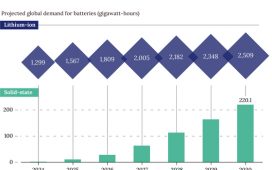Flow batteries, a long-promised solution to the vicissitudes of renewable energy production, boast an outsize ratio of hype to actual performance. These batteries, which store electricity in a liquid electrolyte pumped through tanks, have been kicking around in labs for ages and in startup pitch decks for the last couple of decades. The technology’s promoters insist it excels where lithium-ion batteries are weak, but grid-storage buyers keep failing to notice.
But the flow-battery sector’s slow roll didn’t stop a relative newcomer, Germany’s CMBlu, from pulling in 100 million euros last month. European construction-services firm Strabag made that investment while promising to lend its infrastructural expertise to help install the batteries around the world.
To contextualize the scale of this funding, it comes close to what was once the largest-ever equity investment for a grid-storage hardware startup, announced just four years ago (that was for Energy Vault’s block-stacking robo-crane, since discontinued). These days, the check sizes have gotten bigger — see Form Energy’s $450 million round last fall — but CMBlu may well have pulled in the largest venture investment for the subcategory of flow-battery startups. Fellow flow-battery-maker ESS, which already has a real factory and real installations, raised a total of $57 million from venture investors before going public via a special-purpose acquisition company (SPAC) in 2022.
So what is CMBlu doing differently to break through the flow-battery malaise and make a technology that really helps decarbonize the electric grid?
Ben Kaun, president of CMBlu’s U.S. division, told Canary Media earlier this fall that the company stands apart from the flow-battery pack by augmenting liquid electrolytes with solid components to squeeze more energy storage into its physical footprint. And by choosing organic components, CMBlu avoids having to use the often-controversial minerals that mainstream clean-energy technologies rely on.
“We’re transitioning from a fossil fuel economy to a renewables and metals economy — there’s so much metal” needed to manufacture wind, solar and conventional batteries, Kaun said. In contrast, “What we have here at CMBlu is a rechargeable polymer, a rechargeable plastic. We can make the plastic [and] recycle the plastic.”
That pitch has won two large-scale contracts with U.S. utilities and a couple in Europe, demonstrating some commercial traction for the unusual liquid-solid batteries. CMBlu is building an automated pilot factory in Alzenau, Germany and plans to install that system at larger-scale factories in one or more parts of the U.S. in 2025.
Bodily inspiration for energy-dense flow batteries
CMBlu’s U.S. chief brings an informed perspective to the role — Kaun spent the previous 12 years researching the whole swath of long-duration storage contenders for the nonprofit Electric Power Research Institute. CMBlu managed to lure him from analyzing the field to competing in it.
CMBlu founder Peter Geigle previously worked on energy management within brain cells as a medical doctor and biotech entrepreneur, Kaun told me at the RE+ trade show in Las Vegas this September. The human brain, incidentally, runs on electricity but doesn’t require piles of lithium and cobalt. Geigle’s understanding of how the body stores and transmits energy via organic materials propelled CMBlu’s unique approach to flow batteries.
CMBlu fills its storage tanks with a solid polymer that holds a charge, and then transfers it to and from the liquid electrolyte, which is pumped into an electrode stack for charging and discharging cycles. Kaun likened that system to how the human body stores energy in fat, and then transfers that energy to blood sugar when it needs to be delivered to cells.
This mimicking of human anatomy could give CMBlu an edge in the metric of energy density, or how much storage capacity can be packed into the physical footprint of the product.
Generally speaking, flow batteries and other non-lithium-ion storage devices sprawl out a bit — they don’t have to squeeze into the chassis of a sports car, so companies are willing to try less-dense approaches. But even though power plants can accommodate more spacious battery technologies, there are costs to letting things get bloated.











